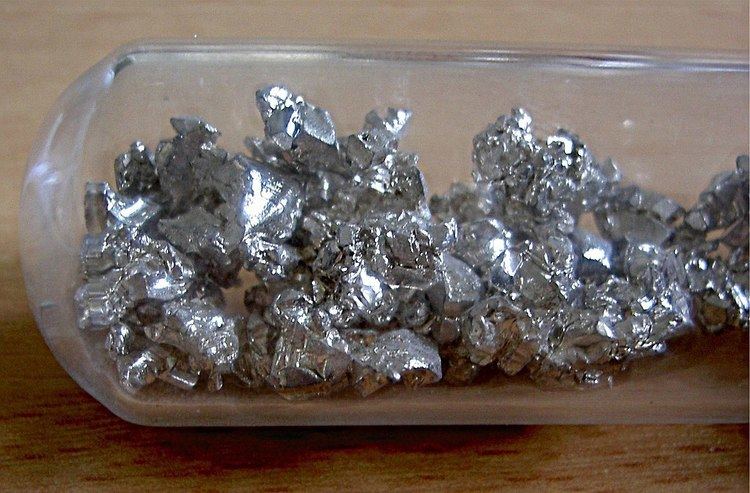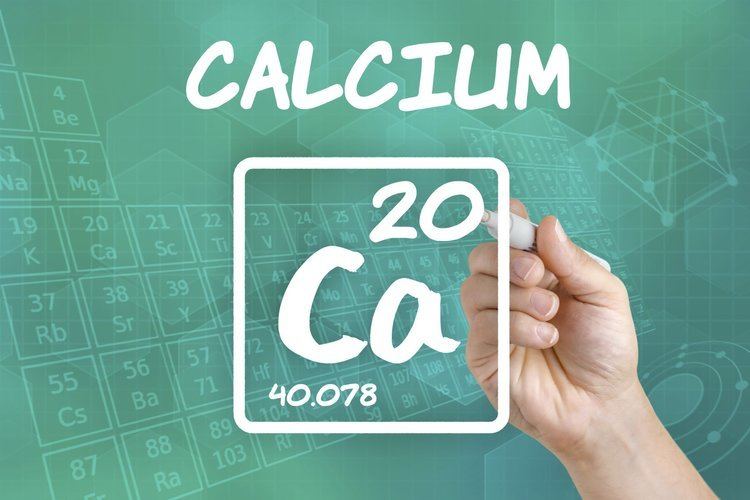Name, symbol calcium, Ca Symbol Ca Atomic number 20 Melting point 842 °C | Pronunciation /ˈkælsiəm/KAL-see-əm Atomic mass 40.078 u ± 0.004 u Electron configuration [Ar] 4s2 Discovered 1808 | |
 | ||
Appearance dull gray, silver; with a pale yellow tint Group, block group 2 (alkaline earth metals), s-block | ||
Calcium
Calcium is a chemical element with symbol Ca and atomic number 20. Calcium is a soft gray Group 2 alkaline earth metal, fifth-most-abundant element by mass in the Earth's crust. The ion Ca2+ is also the fifth-most-abundant dissolved ion in seawater by both molarity and mass, after sodium, chloride, magnesium, and sulfate. Free calcium metal is too reactive to occur in nature. Calcium is produced in supernova nucleosynthesis.
Contents
- Calcium
- Calcium periodic table of videos
- Uses
- Physiology
- Cell physiology
- Dietary supplement
- Toxicity
- Notable characteristics
- H and K lines
- Compounds
- Isotopes
- Isotope fractionation
- Geochemical cycling
- History
- References

Calcium is an essential trace element in living organisms. It is the most abundant metal by mass in many animals, and it is an important constituent of bone, teeth, and shells. In cell biology, the movement of the calcium ion into and out of the cytoplasm functions as a signal for many cellular processes. Calcium carbonate and calcium citrate are often taken as dietary supplements. Calcium is on the World Health Organization's List of Essential Medicines.

Calcium periodic table of videos
Uses
Calcium has a wide variety of applications, almost all of which are associated with calcium compounds and salts.

Physiology

In solution, the calcium ion varies remarkably to the human taste, being reported as mildly salty, sour, "mineral-like", or even "soothing." It is apparent that many animals can taste, or develop a taste, for calcium, and use this sense to detect the mineral in salt licks or other sources. In human nutrition, soluble calcium salts may be added to tart juices without much effect to the average palate.

Calcium is an important component of a healthy diet and a mineral necessary for life. The National Osteoporosis Foundation states, "Calcium plays an important role in building stronger, denser bones early in life and keeping bones strong and healthy later in life." Approximately 99 percent of the calcium in the human body is in the bones and teeth. Intracellular calcium overload can cause oxidative stress and apoptosis in some cells, sometimes leading to several diseases. In the electrical conduction system of the heart, calcium replaces sodium as the mineral that depolarizes the cell, proliferating the action potential. In cardiac muscle, sodium influx commences an action potential, but during potassium efflux, the cardiac myocyte experiences calcium influx, prolonging the action potential and creating a plateau phase of dynamic equilibrium. Long-term calcium deficiency can lead to rickets and poor blood clotting; in menopausal women, deficiency can lead to osteoporosis, a condition in which the bone deteriorates and fractures more readily. While a lifelong deficit of calcium can affect bone and tooth formation, over-retention can cause hypercalcemia (elevated levels of calcium in the blood), impaired kidney function, and decreased absorption of other minerals. Vitamin D is needed to absorb calcium.
Cell physiology

The release of calcium ions from the sarcoplasmic reticulum into the cytoplasm is an essential intracellular signal, important in many cellular functions and processes, including muscle contraction, neuronal transmission as in an excitatory synapse, cellular motility (including the movement of flagella and cilia), fertilisation, cell growth or proliferation, learning, memory (as with synaptic plasticity), and secretion of saliva. Calcium signalling can be studied by loading a cell's cytoplasm with a calcium-sensitive fluorescent dye such as Fura-2. Many of these dyes were developed by Roger Y. Tsien.
Dietary supplement

Calcium supplements are used to prevent and to treat calcium deficiencies. However, it has been found that the taking of calcium supplements by people with a history of stroke or with white matter lesions greatly increased their chances of developing dementia. The Office of Dietary Supplements (National Institutes of Health) recommends that no more than 600 mg of supplement should be taken at a time because the percent of calcium absorbed decreases as the amount of calcium in the supplement increases. It is therefore recommended to spread doses throughout the day. Recommended daily calcium intake for adults ranges from 1000 to 1300 mg. Calcium supplements may have side effects such as bloating and constipation in some people. It is suggested that taking the supplements with food may aid in nullifying these side effects.
Toxicity
Compared with other metals, the calcium ion and most calcium compounds have low toxicity. This is not surprising, given the very high natural abundance of calcium compounds in the environment and in organisms.
Calcium poses few serious environmental problems.

Calcium metal is hazardous because of its sometimes-violent reactions with water and acids. Calcium metal is found in some drain cleaners, where it functions to generate heat and calcium hydroxide that saponifies the fats and liquefies the proteins (e.g., hair) that block drains. When swallowed, calcium metal has the same effect on the mouth, esophagus, and stomach, and can be fatal.
Notable characteristics
Calcium can be extracted by electrolysis from a fused salt like calcium chloride. Calcium is relatively soft for a metal; although harder than lead, it can be cut with a knife with difficulty. Calcium is chemically reactive; when exposed to the air, it rapidly forms a gray-white coating of calcium oxide and calcium nitride. In bulk form (typically as chips or "turnings"), the metal is somewhat difficult to ignite, more difficult even than magnesium chips; but, when lit, the metal burns in air with a brilliant high-intensity orange-red light. Calcium metal reacts with water, producing hydrogen gas at a moderate rate without generating much heat, making it useful for generating hydrogen. In powdered form, however, the reaction with water is extremely rapid, as the increased surface area of the powder accelerates the reaction. Part of the reason for the slowness of the calcium–water reaction is a partial passivation (chemically protective coating) of insoluble white calcium hydroxide; in acidic solutions, where this compound is more soluble, calcium reacts vigorously.
With a density of 1.54 g/cm3, calcium is the lightest of the alkaline earth metals; magnesium (specific gravity 1.74) and beryllium (1.84) are denser though lighter in atomic mass. From strontium onward, the alkali earth metals become denser with increasing atomic mass. Calcium has two allotropes.
Calcium metal has a higher electrical resistivity than copper or aluminium, yet weight-for-weight, due to its much lower density, it is a better conductor than either. Its use as such in terrestrial applications is usually limited by its high reactivity with air; however, it has potential for use as wiring in off-world applications.
Calcium is the fifth-most-abundant element by mass in the human body, where it is a cellular ionic messenger with many functions. Calcium also serves as a structural element in bone. It is the relatively high atomic number of calcium that causes bone to be radio-opaque.
H and K lines
Visible spectra of many stars, including the Sun, exhibit strong emission lines of singly ionized calcium. Prominent among these are the H-line at 3968.5 Å and the K line at 3933.7 Å of singly ionized calcium, or Ca II. In the Sun or other stars with low temperatures, the prominence of the H and K lines in the visible spectra can be an indication of strong magnetic activity in the chromosphere.
Compounds
Calcium chemistry is almost exclusively that of Ca2+ salts. Ca2+ is a "hard cation", that is, it characteristically favors oxide ligands. Hence the abundance of carbonates, nitrates, phosphates, and sulfates in the mineral kingdom. Many of these species crystallize with water. Because it is generally nontoxic and abundant, calcium is found in many foods and useful materials. Most calcium salts are colorless. As with magnesium salts and other alkaline earth metal salts, the halides are soluble in water.
Combined with phosphate, calcium forms hydroxylapatite (Ca5(PO4)3(OH)), the mineral portion of animal bones, teeth, and some corals. Large-scale chemical processes are involved in the conversion of calcium phosphate minerals into fertilizer.
Calcium is the main problematic ion in hard water: it forms insoluble deposits of calcium carbonate that are problematic in plumbing. It also reacts with soap to form soap scum. Calcium carbonate occurs naturally as limestone and chalk. When water percolates through limestone or other calcium-containing rocks, it partially dissolves the rock. The slow re-precipitation of minerals derived from dissolved calcium leads to formation of stalactites and stalagmites.
When heated above 825 °C, calcium carbonate converts calcium oxide (CaO), also known as quicklime:
CaCO3 → CaO + CO2When added to water, quicklime vigorously reacts (hence its name) to form calcium hydroxide:
CaO + H2O → Ca(OH)2Also known as slaked lime, Ca(OH)2 is an inexpensive base material used throughout the chemical industry. When mixed with sand, it hardens into a mortar and is turned into plaster by carbon dioxide uptake. Mixed with other compounds, lime forms an important part of Portland cement.
Combined with sulfate, calcium forms the mineral gypsum. When heated to about 300 °F (150 °C), it undergoes partial dehydration:
CaSO4·2H2O → CaSO4·0.5H2O + 1.5 H2OThe resulting powder, when mixed with water, forms a stiff but workable paste that hardens to give Plaster of Paris.
Organocalcium compounds, those containing Ca-C bonds are known, but generally of specialized interest in the research laboratory. One major exception is calcium carbide, which arises from heating calcium compounds with coal or other carbon-rich reducing agents.
CaO + 3 C → CaC2 + COIt was historically important precursor to acetylene.
CaC2 + 2 H2O → C2H2 + Ca(OH)2Other important calcium compounds are calcium nitrate used in fertilizers, calcium chloride used as for deicing roads, calcium cyanamide, and calcium hypochlorite, used for bleaching.
Focusing on chemical structure, Ca2+ is a relatively large ion that tends to adopt a high coordination number. In CaF2, the mineral fluorite, each Ca2+ ion is surrounded by eight F− ligands.
Isotopes
Calcium has five stable isotopes (40Ca, 42Ca, 43Ca, 44Ca and 46Ca), plus one more (48Ca) that has such a long half-life, it can be considered stable for many purposes. The 20% range in relative mass among naturally occurring calcium isotopes is greater than for any element other than hydrogen and helium. Calcium also has a cosmogenic isotope, radioactive 41Ca, which has a half-life of 103,000 years. Unlike cosmogenic isotopes produced in the atmosphere, 41Ca is produced by neutron activation of 40Ca, primarily in the top metre of the soil column, where the cosmogenic neutron flux is sufficiently strong. 41Ca has received much attention in stellar studies because it decays to 41K, a critical indicator of solar-system anomalies.
Ninety-seven percent of naturally occurring calcium is in the form of 40Ca, which is a daughter product of 40K and 40Ar decay. While K–Ar dating is used extensively in the geological sciences, the prevalence of 40Ca in nature has impeded its use in dating. Techniques using mass spectrometry and a double spike isotope dilution are used for K-Ca age dating.
40Ca has a nucleus of 20 protons and 20 neutrons and is the heaviest stable isotope of any element that has equal numbers of protons and neutrons. In supernova explosions, calcium is formed from the reaction of carbon with various numbers of alpha particles (helium nuclei), until the most common calcium isotope (containing 10 helium nuclei) has been synthesized.
Isotope fractionation
As with the isotopes of other elements, a variety of processes fractionate, or alter the relative abundance of, calcium isotopes. The best studied of these processes is the mass-dependent fractionation of calcium isotopes that accompanies the precipitation of calcium minerals, such as calcite, aragonite and apatite, from solution. Isotopically light calcium is preferentially incorporated into minerals, leaving the solution from which the mineral precipitated enriched in isotopically heavy calcium. At room temperature the magnitude of this fractionation is roughly 0.25‰ (0.025%) per atomic mass unit (AMU). Mass-dependent differences in calcium isotope composition conventionally are expressed by the ratio of two isotopes (usually 44Ca/40Ca) in a sample compared to the same ratio in a standard reference material. 44Ca/40Ca varies by about 1% among common earth materials.
Calcium isotope fractionation during mineral formation has led to several applications of calcium isotopes. In particular, the 1997 observation by Skulan and DePaolo that calcium minerals are isotopically lighter than the solutions from which the minerals precipitate is the basis of analogous applications in medicine and in paleooceanography. In animals with skeletons mineralized with calcium, the calcium isotopic composition of soft tissues reflects the relative rate of formation and dissolution of skeletal mineral. In humans, changes in the calcium isotopic composition of urine have been shown to be related to changes in bone mineral balance. When the rate of bone formation exceeds the rate of bone resorption, the ration 44Ca/40Ca in soft tissue rises. Soft tissue 44Ca/40Ca falls when bone resorption exceeds bone formation. Because of this relationship, calcium isotopic measurements of urine or blood may be useful in the early detection of metabolic bone diseases like osteoporosis.
A similar system exists in the ocean, where 44Ca/40Ca in seawater tends to rise when the rate of removal of Ca2+ from seawater by mineral precipitation exceeds the input of new calcium into the ocean, and fall when calcium input exceeds mineral precipitation. It follows that rising 44Ca/40Ca corresponds to falling seawater Ca2+ concentration, and falling 44Ca/40Ca corresponds to rising seawater Ca2+ concentration. In 1997 Skulan and DePaolo presented the first evidence of change in seawater 44Ca/40Ca over geologic time, along with a theoretical explanation of these changes. More recent papers have confirmed this observation, demonstrating that seawater Ca2+ concentration is not constant, and that the ocean probably never is in “steady state” with respect to its calcium input and output. This has important climatological implications, as the marine calcium cycle is closely tied to the carbon cycle (see below).
Geochemical cycling
Calcium provides a link between tectonics, climate, and the carbon cycle. In the simplest terms, uplift of mountains exposes calcium-bearing rocks to chemical weathering and releases Ca2+ into surface water. This Ca2+ eventually is transported to the ocean where it reacts with dissolved CO2 to form limestone. Some of this limestone settles to the sea floor where it is incorporated into new rocks. Dissolved CO2, along with carbonate and bicarbonate ions, are termed "dissolved inorganic carbon" (DIC).
The actual reaction is more complicated and involves the bicarbonate ion (HCO−
3) that forms when CO2 reacts with water at seawater pH:
+ 2HCO−
3 → CaCO
3 (limestone) + CO
2 + H
2O
Note that at seawater pH, most of the CO2 is immediately converted back into HCO−
3. The reaction results in a net transport of one molecule of CO2 from the ocean/atmosphere into the lithosphere.
The result is that each Ca2+ ion released by chemical weathering ultimately removes one CO2 molecule from the surficial system (atmosphere, ocean, soils and living organisms), storing it in carbonate rocks where it is likely to stay for hundreds of millions of years. The weathering of calcium from rocks thus scrubs CO2 from the ocean and atmosphere, exerting a strong long-term effect on climate. Analogous cycles involving magnesium, and to a much smaller extent strontium and barium, have the same effect.
As the weathering of limestone (CaCO3) liberates equimolar amounts of Ca2+ and CO2, it has no net effect on the CO2 content of the atmosphere and ocean. The weathering of silicate rocks like granite, on the other hand, is a net CO2 sink because it produces abundant Ca2+ but very little CO2.
History
Lime as building material was used since prehistoric times going as far back as 7000 to 14000 BC. Statues made from lime plaster have been dated into the 7 millennia BC. The first dated lime kiln dates back to 2500 BC and was found in Khafajah mesopotamia. Calcium (from Latin calx, genitive calcis, meaning "lime") was known as early as the first century when the Ancient Romans prepared lime as calcium oxide. Literature dating back to 975 AD notes that plaster of paris (calcium sulfate), is useful for setting broken bones. It was not isolated until 1808 in England when Sir Humphry Davy electrolyzed a mixture of lime and mercuric oxide. Calcium metal was not available in large scale until the beginning of the 20th century.
